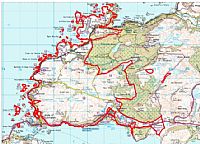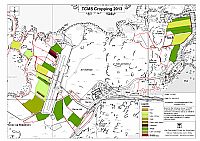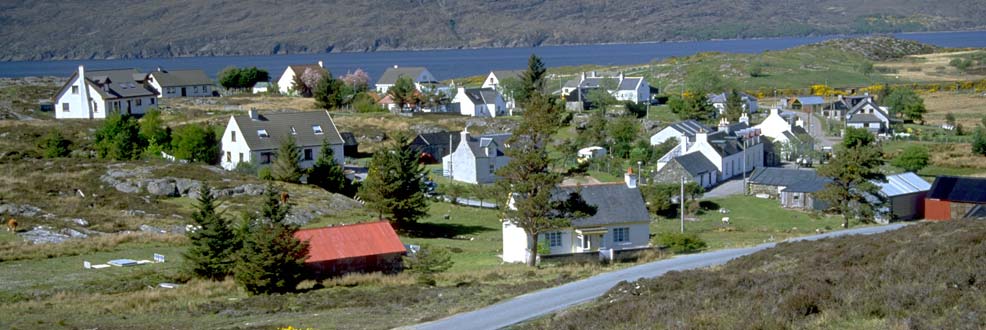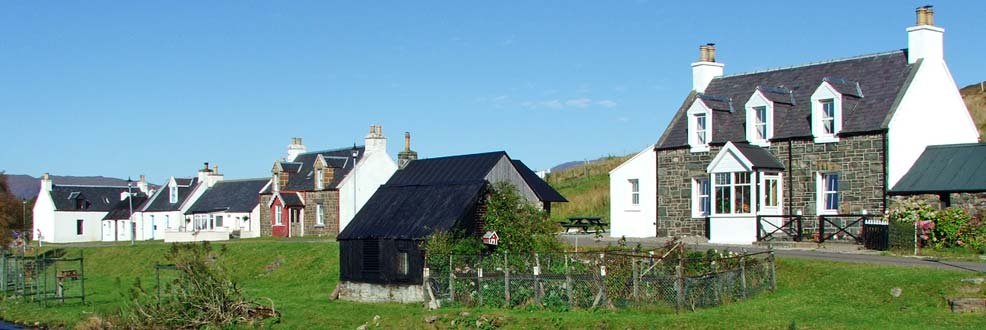Balmacara Traditional Croft Management Scheme - Introduction
 The Balmacara Estate is owned by The National Trust for Scotland (NTS) and is situated at the western end of the Lochalsh peninsula and extends to c.2,500 hectares. Approximately 75% of the estate is under crofting tenure with 83 registered crofts in eight crofting townships. Crofting activity has remained at a relatively high level in the area with the majority of in-bye croft land being worked in some manner. Traditional crofting agricultural practices, defined here as extensive rotational cropping and the rearing of cattle, are most prominent in the townships of Drumbuie, Duirinish and Plockton. The prominence of cattle within these townships bucks the trend that can be seen across the Crofting Counties where sheep have become the predominant form of livestock and cattle numbers have declined. Similarly, the levels of cropping and cutting of hay, and to a lesser extent silage, have also declined, probably in part as a result of the decline in cattle numbers.
The Balmacara Estate is owned by The National Trust for Scotland (NTS) and is situated at the western end of the Lochalsh peninsula and extends to c.2,500 hectares. Approximately 75% of the estate is under crofting tenure with 83 registered crofts in eight crofting townships. Crofting activity has remained at a relatively high level in the area with the majority of in-bye croft land being worked in some manner. Traditional crofting agricultural practices, defined here as extensive rotational cropping and the rearing of cattle, are most prominent in the townships of Drumbuie, Duirinish and Plockton. The prominence of cattle within these townships bucks the trend that can be seen across the Crofting Counties where sheep have become the predominant form of livestock and cattle numbers have declined. Similarly, the levels of cropping and cutting of hay, and to a lesser extent silage, have also declined, probably in part as a result of the decline in cattle numbers.
Whilst the current crofting situation on the Balmacara Estate is relatively healthy, the NTS is concerned that this may change in the coming years. With ongoing pressures on crofting from the inherent economic difficulties associated with small scale agriculture, relatively poor agricultural environment, remoteness from markets and reform of the Common Agricultural Policy (CAP) and poorly targeted support systems there is a likelihood that there will be an increase in movement away from crofting agriculture towards other uses of the land. The NTS values very highly the heritage value of these crofting townships, both in terms of the rich cultural aspects and in terms of the resultant biodiversity and landscapes. If there is a downturn in the levels of these traditional activities there will be an attendant impact on these important cultural and natural heritage assets.
So against this background the NTS resolved to attempt to maintain and protect these important cultural landscapes and their attendant biodiversity by supporting and encouraging the continuation of these traditional practices through a combination of measures set out in the Traditional Croft Management Scheme. The scheme was introduced in 2006 and was a great success with 15 crofters taking part. Numbers increased to 20 crofters in 2007 and based on the experience of the first two years it was decided to continue the scheme and it has been running since.
This scheme recognises that there is a wide range of subsidies and support available for agriculture in the United Kingdom, but it is also the view of the NTS that many of these subsidy and support systems are not well designed to encourage the continuation of crofting agriculture. Many of the problems faced by crofters, such as the small scale of their operations, remoteness, unfavourable ground and climatic conditions, etc. are not dealt with effectively by these systems. Many of the schemes are highly prescriptive and administratively burdensome, especially when one considers the scale of the operations involved. Management prescriptions are frequently designed for national priorities that appear to focus on encouraging mainstream intensive farmers into more environmentally friendly agricultural practices. While this is clearly a laudable and beneficial objective nationally, the NTS has concerns that some of these broader prescriptive approaches can lead to operations that do not take into account adequately the requirements of each site. Thus, this scheme aims to overcome some of these issues to deliver a relatively simple approach to supporting the key elements of traditional crofting, i.e. retention of cattle and rotational cropping. It is the NTS’ view that by supporting these key elements of crofting the other aspects of the landscape, environment and cultural heritage will generally look after themselves. Therefore, the broad aim of this scheme can be expressed in fairly simple terms as follows:
Traditional Croft Management Scheme - Aim
To encourage the continuation of traditional crofting practices on the Balmacara Estate as a means of ensuring the protection and enhancement of the increasingly rare croft landscapes and associated species and habitats and the strong cultural identity associated with crofting.
This relatively simple aim can be further broken down to more meaningful and specific objectives that reflect the range of measures that the NTS employs to achieve this broad aim. The two core elements are simply the encouragement of rotational cropping and retention of cattle. For this scheme rotational cropping entails the growing of a mixture of crops, not necessarily in the same year but preferably with some element of rotation from year to year. Typically those crops might include potatoes, turnips, cereals for winter feed (e.g. peas, oats, barley, etc.), hay and/or silage. This rotational system ensures that the land is kept in good condition and fertility levels are maintained and pest species are kept under control. The scheme is also concerned with developing the linkages between keeping cattle and the growing of crops for winter feed. Therefore, it is intended to integrate a link within this scheme as part of the encouragement for the retention of cattle. In addition to these linkages, the NTS would ideally like to see an increase in the amount of species-rich hay meadow within the areas that are cropped for grass. However, it is recognised that this will incur additional costs to crofters and so measures are included to support this. In terms of cultural heritage, recognition is given to the more traditional practice of growing hay as opposed to silage and measures are included in the scheme to support the extra costs associated with this.
In summary the specific objectives of this scheme as are follows:
Traditional Croft Management Scheme – Objectives
- Encourage and support the continuation and development of traditional rotational cropping in the townships of Drumbuie, Duirinish and Plockton;
- Encourage and support the retention of cattle within these crofting townships;
- Foster the strong link between the retention of cattle and the cropping of croft land;
- Encourage the expansion of species-rich hay meadows and the preference of hay production over silage.
- Ensure that such support and encouragement is delivered in an administratively efficient and flexible manner.
There are two critical elements to the scheme, firstly direct support for rotational cropping, and secondly support for the retention of cattle. The Trust also offers additional support for more traditional elements of cropping, e.g. hay instead of silage and late-cut to enhance the species diversity of the meadows.
Rotational Cropping
The scheme makes payments to crofters who undertake to carry out cropping activities on their croft. These payments do affect their entitlement to other subsidies and support measures. Varying rates are paid according to the type and areas of crops being grown but as shown in the table below.
| Cropping Payments | |
|---|---|
| Potatoes | £520/ha |
| Turnips | £520/ha |
| Cereals | £420/ha |
| Grass Crop | £200/ha |
| Hay Premium | £100/ha |
| Species-rich Premium | £100/ha |
| All payments are annual and subject to confirmation of area, although a minimum payment of £50 will be made for each crop of potatoes, turnips or cereals. | |
These payments were calculated according to estimates of the actual cost of production for a crofter in the west highlands (at 2005 prices). The costs take into account an allowance for seed, fertiliser, lime (if required), ploughing, harrowing, Farm Yard Manure application, harvesting, reseeding and fuel, plus they account for the value lost from the area taken out of pasture and the value of the crop itself. For the grass crops a basic payment is made if the crofter grows a grass crop, e.g. silage. If the crofter cuts that crop for hay, as opposed to silage a premium of £100 per hectare is payable. If the grass crop is deemed to be species-rich a premium of £100 per hectare is payable. To qualify for the species-rich premium the crofter must delay cutting until after 1st August. This allows the various floristic species to set seed before being harvested. The premium payment recognises the potential loss of productive value of the crop and the risk of loss or damage to the crop from the weather. The payments for other crops, i.e. potatoes and/or turnips will be subject to a maximum area of 0.25 ha each per croft.  This is to avoid whole crofts being turned over to production of these crops that would lead to a reduction in the diversity of the overall crofting system within any given township. Areas that have been used for one of the three main crops ideally should not be used for the same crop the following year in order to avoid over-cultivation of small areas of ground. However, there is a minimum payment of £50 for each crop of potatoes, turnips or cereals.
This is to avoid whole crofts being turned over to production of these crops that would lead to a reduction in the diversity of the overall crofting system within any given township. Areas that have been used for one of the three main crops ideally should not be used for the same crop the following year in order to avoid over-cultivation of small areas of ground. However, there is a minimum payment of £50 for each crop of potatoes, turnips or cereals.
Retention of Cattle
The levels of support for rearing cattle under the existing CAP support mechanisms for farmers and crofters are considered to be inadequate. It has been estimated that the actual cost of rearing these calves is considerably higher than the level of the support within the crofting context and so the scheme aims to assist with these additional costs linked to undertaking some cropping activity as well. This condition reflects the NTS’s desire to underpin the traditional linkages between the rearing of cattle and the production of winter feed on the croft. These links are a central element in the traditional crofting system and the long-term sustainability of crofting agriculture. Crofters qualify for assistance towards the retention of cattle on the following basis:
Retention of Cattle Payments
Crofters are effectively paid a headage payment of £70 per cow reared up to a maximum of their individual souming. (souming is defined as the number of livestock units they are permitted to graze under their share in the common grazings).
Where a crofter has a sublet of another croft, or works the land informally for another crofter who is not in the scheme they can include the souming for that croft as well.
All payments are annual and subject to confirmation of numbers.
Retention of Cattle Payments will only be made to crofters who have agreed to produce some element of cropping on their croft. The payment will be subject to confirmation that the agreed crops and other commitments have been produced.











